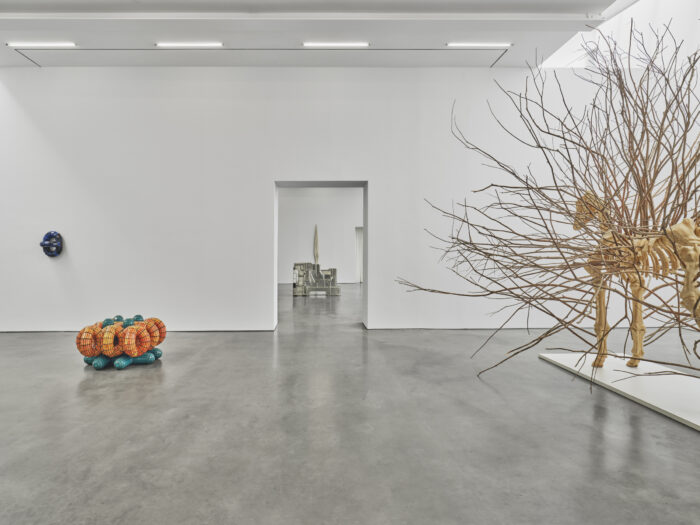
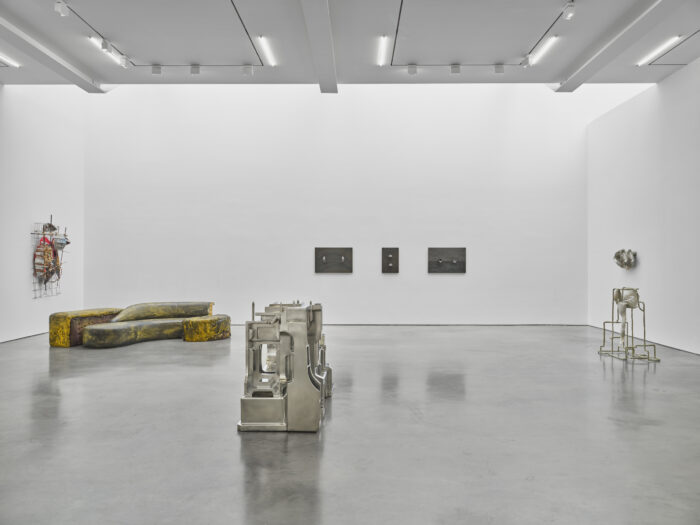
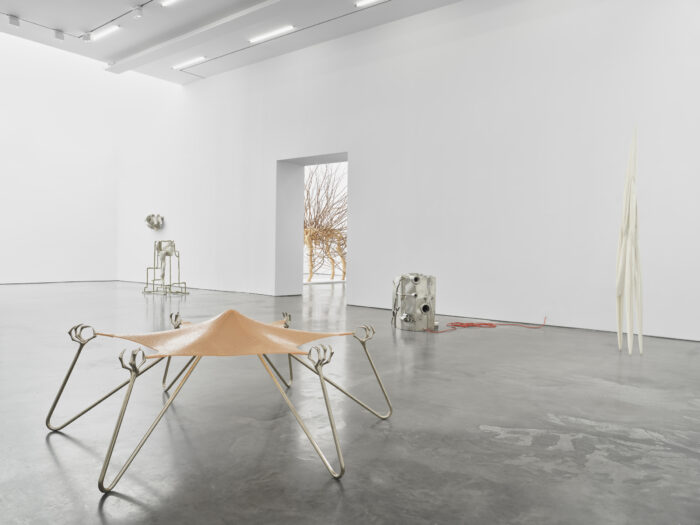
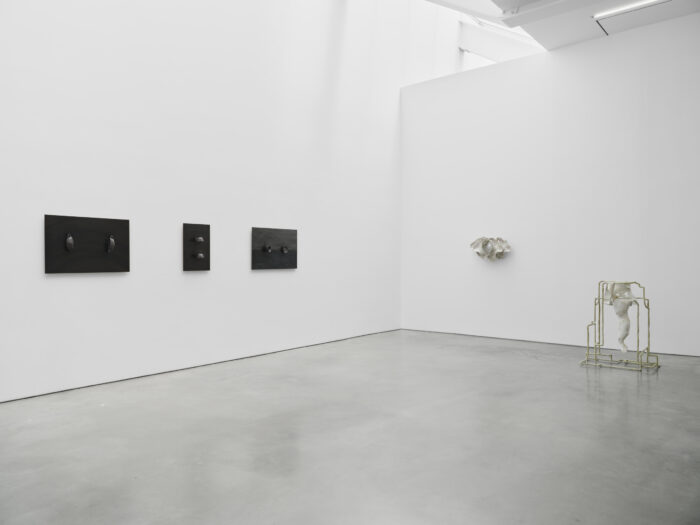
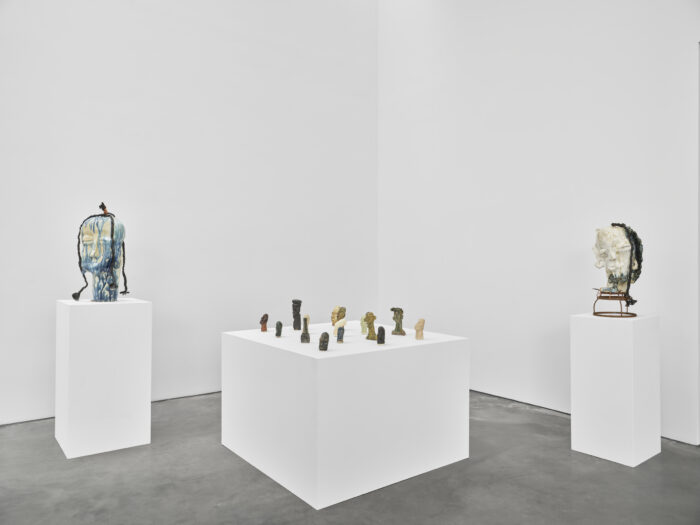
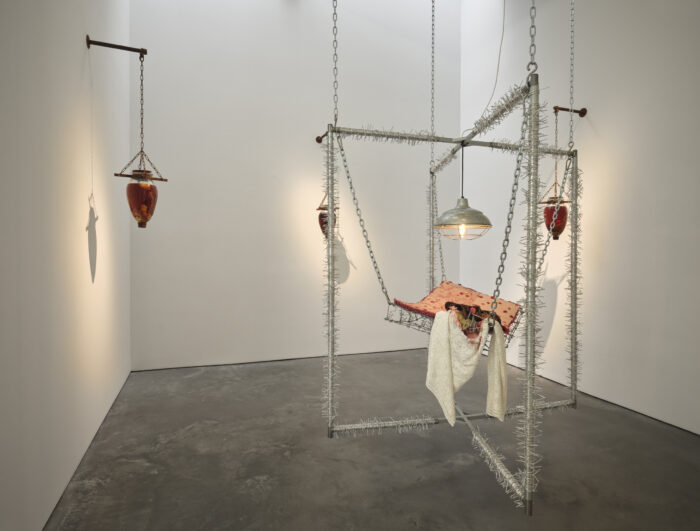
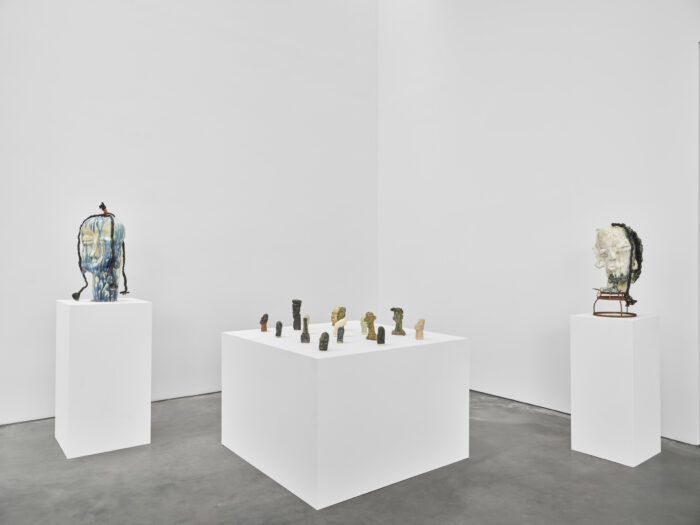

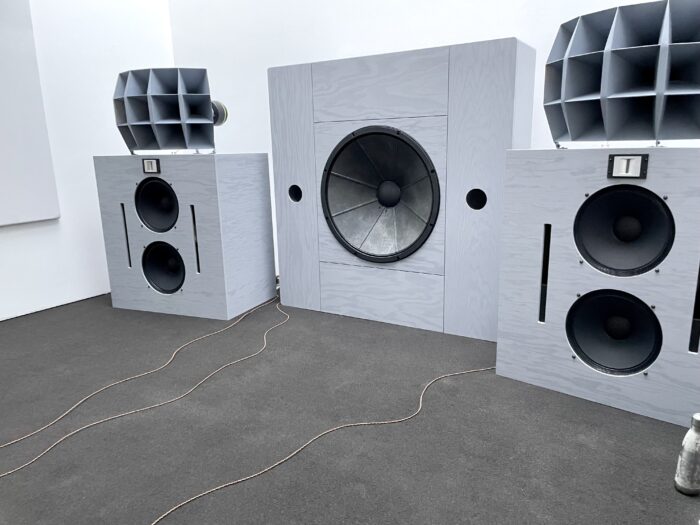
The odds are good, the goods are odd at Lisson Gallery, NYC
June 29 – August 5, 2022
Images (1-7) courtesy of Lisson Gallery
Featuring artists Leilah Babirye, Kristi Cavataro, Jes Fan, Doreen Lynette Garner, Hugh Hayden, Elizabeth Jaeger, Hannah Levy, Eli Ping, Jessi Reaves, Devon Turnbull (OJAS), Kristin Walsh
The odds are good, the goods are odd is a group exhibition that highlights a new generation of New York-based sculptors. Bringing together artworks across a range of mediums, the presentation showcases the divergent ethoses behind sculpture-making today. The featured artists favor the handmade, creating a spectrum of artworks that range from the polished and conceptual, to the raw and visceral.
United through the use of atypical materials, the eleven artists in the exhibition inhabit a field outside of the sculptural norm and resist a trend-driven system. They opt, instead, to confront formality. The artists share an interest in how the human body, its strength and its fragility, is challenged by innumerable contemporary forces — from disease and illness to a dislocation in a digital world. They employ laborious practices and through their respective methods, from collecting detritus during their travels to precise sharpening of their constructions, the presence of the artists’ hands on the work remains unmistakable. The exhibition aims to accentuate the atypical disciplines that inform the orientation of sculpture-making today.
A colossal equine by Hugh Hayden stands at the entrance of the gallery. In his practice, Hayden begins with objects which inherently carry significant associations with societal categorization: race, religion, ethnicity, education, sexuality and the like. After sourcing specific species of wood, in this case Cypress local to the southeastern United States, Hayden uses a rigorous process of sawing, sanding and sculpting to create recognizable yet twisted forms. The effect is a metaphorical disruption of traditional American social context. The work in the exhibition illustrates a number of recurring themes in Hayden’s iconography; the zebra as a realization of camouflage, and the skeleton for its lack of external identifiers and its suggestion of past, and perhaps impending, extinction.
Across the front gallery are stationed two large stained-glass sculptures, one mounted to the wall and the other situated on the floor, by Kristi Cavataro. The multifaceted structures, at once rounded and cubic, are the product of tedious mathematic calculations and hands-on construction. Cavataro’s practice includes an adaptation of the Louis Comfort Tiffany technique, used in the nineteenth century for Art Nouveau stained glass designs. Cavataro’s glass tiles are individually cut and then soldered into forms that resist the material’s rigid properties. The results are unexpected, architectural shapes. Contorted material continues in a new work from Eli Ping’s Mote series. Canvas becomes a sculptural medium in the pronged, diamond-shaped figure. Ping slits, stretches and pulls the canvas through itself before pouring resin onto the newly elongated and knotted forms, crystallizing them into bone-like matter. The wall-mounted work offers a new formal encounter and may hint at a metaphor under the artificial alabaster.
Eighteen glazed ceramic figures presented by Leilah Babirye examine LGBTQ+ history and confront the cultural traditions surrounding sexuality and human rights in the artist’s native Uganda. Babirye sculpts the clay by hand, and after the work is fired, she dribbles and douses the ceramic sculptures in glaze using unconventional techniques. The figures are then assembled with materials collected from the streets of New York – Mugave Ndugwa from the Kuchu Lugave (Pangolin) Clan and Kinsambwe from the Kuchu Lungfish Clan (both 2022) include copper wire and bicycle tire inner tubes. Babirye deliberately uses dispensed components in her work, citing ‘ebisiyaga’, the derogatory term for queer persons in the Luganda language, that translates to the discarded part of the sugarcane husk. The artist’s recycled materials are a reclamation of her community, and her figures draw from a range of African artistic traditions.
Nearby sit Kristin Walsh’s ominous machines. Working primarily in aluminum, Walsh fabricates sculptures that reference the decreasingly-human worlds of manufacturing and industrialization. Forgoing mass production techniques, Walsh cuts, bends, welds and fuses each sculpture from sheet metals. Her works feature a waxed and highly-polished surface that offers a sense of the platonic ideal of the referenced object, while the handcrafted fabrication repudiates our relationship to mass production. Walsh’s machines have included engineered sounds of clock making that engage with linear notions of time and efficiency. The works in the exhibition transform the typically utilitarian into the dystopic and uncanny.
Three new works by Elizabeth Jaeger, made from ceramic and blackened steel, feature miniature human figures standing inside dark voids or atop hanging teacups. The dioramas explore a fetishization of the middle class, examining symbolic representations of stature and prodding at the societal pressure to have these indications on display. The little bodies appear fragile in their spaces, and the sculptures challenge the viewer to engage with their relationship to their own physicality.
The sculptures of Doreen Lynette Garner engage the body through a historical lens. The artist examines past and present patterns of medically sanctioned racial violence, focusing on medical experimentation on Black women’s bodies in the US and illustrating the consequent indignity. Garner’s 2017 works, Known But To God: The Dug Up, Dissected, and Disposed for the Sake of Medicine, combine a wide range of materials – glass, silicone, steel, epoxy putty, pearls, Swarovski crystals, whiskey – to suggest mangled body parts, bodily fluids and human remains. Lucy’s Agony (2021) furthers the depiction of these experiments, and points to the current inequities in medical care.
Corporeality extends to sculptures by Jes Fan and Hannah Levy. Jes Fan’s Clavicle Repeated Four Times (2022) features molds from the body of an ex-lover. The artist explores the materiality of the gendered body and its intersection with biology. Opting to use the literal substances of biology that have been applied to typify identity, Fan has previously utilized melanin, testosterone, estrogen, urine and other corporal materials in his handblown-glass and pigments. The organic material is incorporated into a larger, inorganic construction. In Rack I (2022), a glass, cadaver-esque form sags over a large assemblage of poured resin and silicone. This anatomical materiality is also displayed in Hannah Levy’s carnal forms. Levy’s visual language is an amalgam of recognizable objects – chairs, shoes, hooks, medical supplies, vegetables – absurdly amended by the addition of stretched silicone. The polished steel and exaggerated formal properties in Levy’s structures take an enigmatic position between sensual object and operative furniture.
Jessi Reaves constructs her furniture out of humble materials often found or scavenged. Her sculpted forms, handmade and at times irrational, are never fully detached from function. In European Yellow Couch (2018), Reaves transforms the upholstered sofa, cutting, painting and rearranging to turn the figure inside out, revealing a new definitive structure. Reaves’ objects are a funhouse facsimile of their original design, questioning the purpose of construction and toying with perceptions of practicality and aesthetics.
A listening room crafted by Devon Turnbull is also featured in the exhibition, a rare foray into the sculptural realm for the audio- and designed-inclined multidisciplinarian. Trained as an audio engineer, Turnbull, who also goes by the creative pen name OJAS, creates high efficacy speakers and low powered tube amplifiers by hand. Each sound sculpture is unique, and Turnbull meticulously sources rare audio parts to build his intricate, yet minimally-designed constructions. Throughout the run of the exhibition, the gallery will present week-long, focused programs in the listening room that feature rare music records and additional audio highlights.
About the artists
Leilah Babirye
(b. 1985, Kampala, Uganda) Babirye studied art at Makerere University in Kampala (2007–2010) and participated in the Fire Island Artist Residency (2015). She created a site-responsive work for ‘Black Atlantic’, a Public Art Fund project at Brooklyn Bridge Park, New York, which opened in May 2022. Her work is included in ’52 Artists: Revisiting a Feminist Milestone’ at The Aldrich, Ridgefield, Connecticut, which runs through January 2023. In 2018, the artist was granted asylum in the US and presented her first solo show at Gordon Robichaux, New York. Her second opened in October 2020 and the gallery also hosted a pop-up exhibition of Babirye’s work in Los Angeles, California in February 2022. Her work can be found in public collections including Hessel Museum of Art, Bard College, Annandale-On-Hudson, New York; Museum of Art, Rhode Island School of Design, Providence, Rhode Island and Sammlung Goetz, Munich, Germany.
Kristi Cavataro
(b. 1992, Connecticut, US) received her BFA from The School of Art at The Cooper union in 2015. Her work is currently included in Greater New York at MOMA, New York, USA (2022) and two previous exhibitions at Ramiken Crucible, New York, USA.
Jes Fan
(b. 1990, Scarborough, Canada) received his BFA in glass from Rhode Island School of Design and lives and works in Hong Kong and Brooklyn, USA. Fan originally trained in glass making, but has expanded his practice to encompass diverse mediums and approaches. Fan is the recipient of various fellowships and residencies, including the Pollock-Krasner Foundation Grant (2022), Joan Mitchell Painters and Sculptors Grant (2017), as well as the Jerome Hill Artist Fellowship (2019-2020). Recent exhibitions include Kunsthall Trondheim (2021); X Museum (2020); Rockbund Art Museum, China (2019); Hayward Gallery, UK (2019); Empty Gallery, Hong Kong (2018); and Museum of Arts and Design, USA (2017). Fan has also participated in numerous artist residencies with institutions including the Bemis Center for Contemporary Arts, Recess Art, Smack Mellon and Pioneer Works. He also participated in the Venice Biennale (2022), New Museum Triennial (2021), Liverpool Biennale (2021), Sydney Biennale (2020), Socrates Annual (2019).
Doreen Lynette Garner
(b. 1986, Philadelphia, PA) is an American sculptor and body modifier based in Brooklyn, New York. She holds a BFA in Glass from the Tyler School of Art at Temple University with an MFA in Glass at the Rhode Island School of Design. She is a recipient of the Joan Mitchell Painters and Sculptors Grant, the Toby Devan Lewis award, a Van Lier Fellowship award, a Franklin Furnace Grant and is currently practicing as a sculptor and inscriber of flesh. Garner’s most recent work is currently on view in “Pale in Comparison,” a solo exhibition at the SCAD Museum of Art, Savannah, GA. Select exhibitions include “Steal Kill and Destroy: A Thief Who Intended Them Maximum Harm” -HALLE FÜR KUNST Steiermark (2021) “Greater New York” MoMA PS1 (2021) “She Is Risen” JTT Gallery (2019), STATEMENTS Art Basel (2018), “White Man on A Pedestal” Pioneer Works (2017), “Surrogate Skin: The Biology of Objects” MoCADA (2016), “Ether and Agony” Antenna Gallery NOLA (2016) and “SHINY RED PUMPING” Vox Populi Gallery (2015). Garner has completed residencies at LMCC Workspace Program (2015) Skowhegan School of Painting and Sculpture (2014) Abrons Art Center (2015-16) Pioneerworks (2016) and GAPP Residency at the Toledo Museum of Art (2016).
Hugh Hayden
(b. 1983, Dallas, TX) received his MFA from Columbia University and a Bachelor of Architecture from Cornell University. Recent solo exhibitions include Blaffer Art Museum, Houston, TX, USA (2022), ICA Miami, FL, USA (2021), The Madison Square Park Conservancy, New York, NY, USA (2021), The Princeton University Art Museum, New Jersey, USA (2020) and at White Columns, New York, NY, USA (2018). His work has been included in numerous group exhibitions including Sculpture Center, New York, NY, USA (2021); Hayward Gallery, London, UK (2020); The Shed, New York, NY, USA(2019); Pilot Projects, Philadelphia, PA, USA (2018); Sundance Film Festival, Park City, UT, USA (2015); MoMA PS1, Rockaway Beach, New York, NY, USA (2014); Socrates Sculpture Park, New York, NY, USA (2014); and Abrons Art Center, New York, NY, USA (2013), among others. He is the recipient of residencies at Glenfiddich in Dufftown, Scotland (2014); Abrons Art Center and Socrates Sculpture Park (both 2012), and Lower Manhattan Cultural Council (2011).
Elizabeth Jaeger
(b. 1988, San Francisco, CA) received her BA from Lewis and Clark College in 2011. Recent solo exhibitions include Holes at Jack Hanley Gallery, Gutted at Mister Farenheit, and Brine at Klemm’s in Berlin. The artist has participated in numerous group exhibitions including How To Survive at the Sprengel Museum, Hannover, DE Mirror Cells at the Whitney Museum of American Art, Moma PS1’s Greater New York, Sculpture Center’s In Practice: Fantasy Can Invent Nothing New, and the Aspen Art Museum’s Zombies: Pay Attention!. Most recently, the artist exhibited in Ghosts at Jack Hanley Gallery, Dreamers Awake at White Cube, London, 99 Cents or Less at the Museum of Contemporary Art Detroit, Sticky Fingers at Arsenal Contemporary, and The Sun and the Rainfall II at Galleria Zero, Milan.
Hannah Levy
(b. 1991, New York, New York) Recent solo exhibitions include the High Line, New York (2021); Casey Kaplan, New York (2020); Mother’s Tankstation, Dublin, Ireland (2018); Fourteen30 Contemporary, Portland, Oregon (2017); and White Flag Projects Library, St. Louis, Missouri (2016). Notable group exhibitions include Wege zur Welt – Hilde-brand Collection, G2 Kunsthalle, Leipzig (2019); Campi Magnetici (Magnetic Fields), Gió Marconi, Milan, Italy (2019); The Artist is Present, Yuz Museum, Shanghai, China (2018); I See You, Savannah College of Art and Design Museum, Savannah, Georgia (2018); Being There, Louisiana Museum of Modern Art, Humlebæk, Denmark (2017); Past Skin, MoMA PS1, New York, New York (2017); and Things I Think I Want. Six Positions of Contemporary Art, Frankfurter Kunstverein, Frankfurt, Germany (2017).
Eli Ping
(b. 1977, Chicago, IL) received his MFA from University of Illinois in 2005 and his BFA from Vassar College in 1999. Ping’s work is currently exhibited at Galerie Maria Bernheim, Zurich, Switzerland (2022) and previous shows include Ramiken Crucible, New York, USA (2021), Susen Inglett, New York, USA (2013).
Jessi Reaves
(b. 1986, Portland, OR) received her BFA from the Rhode Island School of Design in 2009. She has received the Teiger Mentor in the Arts from Cornell University in 2020 and was a special mention in the Hublot Design Prize in Switzerland in 2017. Residencies include The Chinati Foundation, Marfa, Texas (2021) and Fallingwater Institute Artist-in-Residence, Mill Run, Pennsylvania (2018). Public collections include the Carnegie Museum of Art, Pittsburgh, Pennsylvania; RISD Museum of Art, Providence, Rhode Island; Whitney Museum of American Art, New York, New York.
Devon Turnbull (OJAS)
(b.1979, Smithtown, NY) OJAS is the creative pen name of Devon Turnbull. As a university student studying Audio Engineering he started using the name across a variety of disciplines including graffiti, music, graphic design and clothing design. In 2003 Turnbull co-founded the clothing brand Nom de Guerre with Isa Saalabi, Wil Whitney and Holly Harnsongkram. For the next decade, while primarily working in fashion, the name OJAS was kept alive on sound sculptures Turnbull was crafting for himself and a growing number of audio enthusiasts around the world. With a particular interest in high efficiency speakers and low powered tube amplifiers, Ojas audio equipment aims to bring realistic, natural sound to the listener. These products are the result of two decades of experimentation, engineering and explorations in the audio underground.
Kristin Walsh
(b. 1989, Emerald Isle, NC) received her MFA from Columbia University in 2017 and her BFA from University of North Carolina at Charlotte in 2013. Recent solo and two-person presentations include: Unworlding, Frieze London, Helena Anrather; The Manner of Working Events, Helena Anrather, New York; NADA House, Helena Anrather, New York; Fjord, Philadelphia; Salisbury University, Salisbury, MD; Selected group exhibitions include: Downs & Ross, New York; Water McBeer, East Hampton, NY; Helena Anrather, New York; Marinaro, New York; SIGNAL, New York; Lenfest Center, Columbia University, New York;; Wassaic Project, Wassaic, NY. Walsh lives and works in New York.
